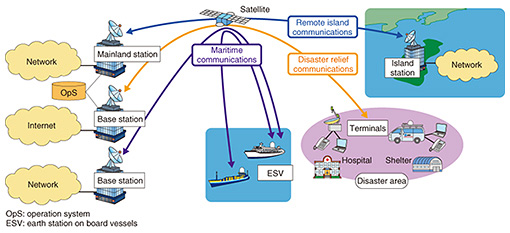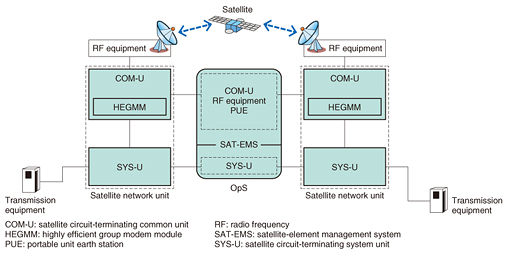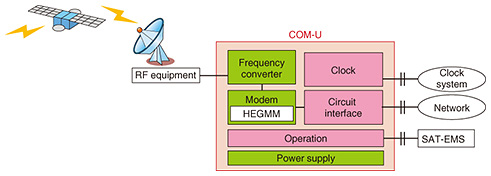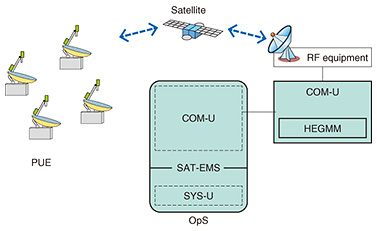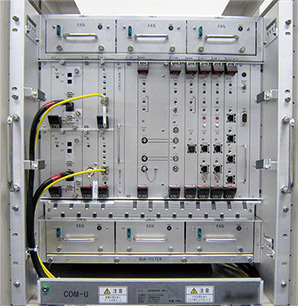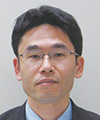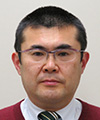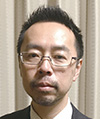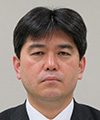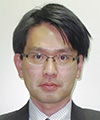 |
|||||
|
|
|||||
|
Regular Articles Vol. 16, No. 5, pp. 33–39, May 2018. https://doi.org/10.53829/ntr201805ra2 Satellite Communications Modem Unit COM-U—Enhanced Maintenance, Operations, and Spectrum Utilization Efficiency of Satellite Transponders for Remote Island Satellite Communications and Disaster Relief Satellite CommunicationsAbstractA major advantage of satellite communications is the ability to implement communication networks virtually anywhere in Japan very simply. The NTT Group has been utilizing satellite communications to provide services in situations where optical fiber, mobile telephony, and other terrestrial facilities are impractical: remote islands, offshore areas, and stricken regions where people have been forced to temporarily flee in the face of earthquakes and other natural disasters. The Group continues to pursue research and development on satellite systems to make them more efficient and advanced. Here we present an overview of NTT’s new satellite communications modem unit called COM-U (satellite circuit-terminating common unit), that markedly improves the spectrum utilization efficiency of satellite transponders and the maintenance and operations of satellite communications used for remote island and disaster relief satellite communications. Keywords: satellite communications, remote island satellite communications, disaster relief satellite communications 1. Highly Efficient Satellite Communications SystemCapitalizing on the inherent advantages of satellite communications—the ability to quickly and easily set up communications networks that provide services over an extensive area—the NTT Group is currently working to extend communications services to places that are inaccessible to optical fiber, mobile telephony, and other terrestrial infrastructure. These areas include remote islands, offshore areas, and stricken regions where people have been forced to evacuate due to natural disasters. The NTT laboratories recognize the necessity and key importance of satellite communications and are therefore pursuing research and development of the Highly Efficient Satellite Communications System (HESCS) that will dramatically improve the efficiency and operability of satellite communications equipment. A schematic overview of HESCS is shown in Fig. 1. HESCS will support three critically important services provided by the NTT Group: disaster relief communications, maritime broadband communications, and remote island communications.
Disaster relief satellite communications can be used to provide a range of essential services in disaster-stricken areas and evacuation centers that have been hit by an earthquake or other natural disaster. Such services include special public telephones and Internet connectivity by rapid deployment of temporary radio links. Maritime broadband satellite communications can provide reliable communications services to ships and seagoing vessels, and finally, remote island satellite communications can provide communications services to residents on remote islands that are not served by submarine optical cable or to provide backup communications in the event that a submarine cable is disrupted. A schematic illustrating HESCS that would be deployed to support remote island satellite communications is shown in Fig. 2. The system consists of a satellite communications modem unit called COM-U (satellite circuit-terminating common unit) featuring a highly efficient group modem module (HEGMM), a satellite circuit-terminating system unit (SYS-U) that connects transmission equipment with the COM-U, and a satellite-element management system (SAT-EMS) with monitoring and control capabilities.
The HEGMM is essentially a key modem module with the ability to send and receive multiple satellite channels at the same time [1]. The COM-U described in this article is a satellite communications modem unit equipped with a HEGMM. In the remote island satellite communications system, the SYS-U connects terrestrial transmission equipment to the COM-U. The SAT-EMS monitors and controls the various elements of the satellite communications system including the SYS-U, COM-U, radio frequency (RF) equipment such as antennas and amplifiers, and the portable unit earth station (PUE). 2. COM-U development conceptIn this section, we explain the concept of COM-U and the improvements achieved with it in maintenance and operations. 2.1 Enhanced utilization efficiency of satellite transpondersThe NTT Group is currently providing services using satellite transponder bandwidth leased from satellite operators. Transponder bandwidth is costly, so it is critical to utilize this bandwidth as efficiently as possible. Guard band settings between adjacent carriers can be greatly reduced by adopting a HEGMM in the COM-U that is capable of allocating carriers at arbitrary speed over arbitrary frequencies. This makes it possible to allocate carriers much closer together than with the prevailing system, which means that transponder bandwidth is significantly reduced assuming the same number of carriers. To put it another way, this markedly increases the number of carriers able to use the same frequency bandwidth. 2.2 Improved maintenance and operationsThe components of the current system are separated function by function, and several devices interwork to terminate satellite lines. This involves a lot of wiring between devices, which requires a lot of extra effort to assemble, install, and replace the wiring. Likewise, increased wiring increases the likelihood that more wiring-related mistakes will occur. The COM-U is compactly integrated in a single housing by packaging functionally similar components together. When the equipment malfunctions, recovery time can be minimized since the technicians only have to replace the malfunctioned package. This single housing configuration means that the number of system components to be maintained is also greatly reduced, which further improves the maintenance and operability. In addition, the various packages for the disaster relief satellite communications system and the remote island satellite communications system are commonly integrated in the same housing. 3. Overview of developmentA functional block diagram of the COM-U is shown in Fig. 3. The COM-U has a disaster relief mode for disaster relief satellite communications and a remote island communications mode for remote island satellite communications, but the functional block is identical. One can see from the figure that the circuit interface connects to the network; the input data from the network are modulated by the HEGMM in the modem, and the modulated signals are then passed to the frequency converter. The signals output from the frequency converter are sent to the RF equipment, which then transmits the signals to the communication satellite transponder.
For the reception function, the RF equipment receives the signals from the satellite transponder and sends them to the COM-U frequency converter. After demodulation by the HEGMM in the modem, the data are output from the circuit interface to the network. The clock subsystem receives a clock from the clock supply module (CSM), generates the required clock in the COM-U from that clock, and distributes it to each component. The operation module is connected to the SAT-EMS by the monitor control network; it monitors and controls the COM-U, PUE, and the RF equipment. All component modules of the COM-U act on control commands from the SAT-EMS. The modules are set, and alarms are collected from each component module. These consist of device alarms warning of equipment failures and communication alarms indicating deterioration of communication quality. These alarms are sent to the SAT-EMS. 3.1 Disaster relief satellite communications systemA schematic of the disaster relief satellite communications system is shown in Fig. 4. In this system, the COM-U connects to the Internet protocol (IP) network via the circuit interface, which interconnects via satellite channels to the PUE set up at the disaster site. The circuit interface of the COM-U for disaster relief communications is equipped with an Ethernet port for connecting to the IP network. In the outbound direction from the COM-U to the PUE, the COM-U unit supports up to thirteen 1536-kbit/s communication channels (with each channel shared by four earth stations), and in the inbound direction from the PUE to the COM-U, the COM-U supports a maximum of fifty-two 384-kbit/s communication channels. Since the current system in service uses the same frequency width and a maximum of 32 channels, the new system greatly expands the channel capacity. In addition to the channels already described, there are also control channels (CSC channels). The SAT-EMS sends control commands to the COM-U to start/stop communication and to set up channels, which are then sent on to the PUE over a CSC channel. Moreover, the COM-U can monitor the operations of up to 52 PUEs via CSC channels, and send an alarm to the SAT-EMS if a malfunction is detected.
In terms of specific services, the PUE can simultaneously provide voice (voice over IP) and IP data communications. To prioritize voice communication from the COM-U to the PUEs, the COM-U has a priority control capability it can impose on IP packets. Priority control is implemented by referring to the PCP (Priority Code Point) value in the VLAN (virtual local area network) tag of the IEEE* 802.1Q frame input from the network. 3.2 Remote island satellite communications systemIn the remote island satellite communications system, the COM-U is connected to the SYS-U at the circuit interface. An RS-422 port is implemented at the circuit interface for remote island communication to connect to the SYS-U. Setting up COM-Us and SYS-Us on both the mainland and island means that the COM-Us are connected via satellite channels, while the transmission switching equipment is also connected by satellite links. The COM-U can simultaneously transmit and receive up to fifteen 1544-kbit/s channels. Telephony, leased-line, and other existing services are delivered over networks using time-division multiplexing, and thus, the operation clocks of devices on the network must be precisely aligned and the entire network synchronized. To achieve network synchronization, the clocks of subordinate or slave devices must be synchronized to the clock supplied from the master clock. In terrestrial systems, clocks from the master clock are typically allocated to each building, where the CSM generates a clock based on the master clock, which the CSM distributes to all equipment in the building. Similarly, network synchronization is required in the remote island satellite communications system in order to provide telephony and leased-line services. Network synchronization is achieved on the mainland side by the CSM, which is supplied over the terrestrial transport network, which then supplies clocks to the various COM-U and SYS-U devices. The island side COM-Us and SYS-Us must also be synchronized to the mainland equipment, which means that the island side CSM must somehow receive a synchronized clock from the mainland CSM. In the remote island satellite communications system, the clock is transmitted to the island over a satellite channel. This is done by first generating a modulated signal in the mainland COM-U using the synchronized clock symbol rate of the mainland CSM. The modulated signal is then transmitted to the island over a satellite channel. The island COM-U then extracts the symbol rate clock from the received modulated signal. A 6.312-MHz signal is generated from the extracted clock, which is then supplied to the island CSM from the island COM-U clock transmitter. As a result of this procedure, the island CSM becomes network synchronized, and the clock is then supplied to all buildings with COM-U and SYS-U equipment on the island. The clock is transmitted to the island over a satellite channel as we have described, but this raises the possibility that the quality of the clock sent from the COM-U to the island CSM could be degraded as a result of radio interference or another problem on the satellite channel. If a poor quality clock is sent to the island CSM, it could adversely affect all of the equipment that relies on the clock. One solution would be to monitor the clock quality at the COM-U clock transmitter and stop the clock from being delivered if it is degraded. For example, if the satellite channel used to send the clock is out of sync, or if the reception level has fallen below a certain level, or the component in the COM-U that handles delivery of the clock has malfunctioned, clock output from the clock transmitter to the island CSM would be suspended. If any of these contingencies occur, services continue based on clock quality that is sufficient at least for the time being by having the island CSM switch over to a free-running clock. A prototype of the new COM-U is shown in Fig. 5. To enhance maintenance and operations of the new system, functional capabilities are implemented as discrete packages, so problems can be quickly and easily resolved by simply swapping out the defective package. The packages are also hot pluggable, so they can be replaced with the power left on without affecting other packages or the main signal transmission. In addition, settings information for each package is backed up in the COM-U and is automatically written to any new package that is installed in the system. This permits fault handling and recovery without bringing in a technician to reset the new package when a failure occurs. The unit also includes remote lamp control, which sets off a blinking alarm on the defective package so the technician can spot the problem package immediately upon arriving at the site.
4. Future developmentWe described here the recent development of the COM-U module—a key component of NTT’s HESCS—that is optimized to improve spectrum utilization efficiency of satellite transponders as well as maintenance and operations. Building on the progress made so far, we will continue to develop and deploy component systems including RF equipment for satellite communications systems that achieve greater cost savings and convenience. AcknowledgmentPart of this work (HEGMM) is being supported by the Ministry of Internal Affairs and Communications of Japan through the funds “Research and Development of Highly Efficient Frequency Use Technique for the Communication Satellite Transponder” and “Research and Development of Capacity Enhancing Technology for Satellite Communications by Employing Dynamic Polarization and Frequency Control.” Reference
|
|||||

